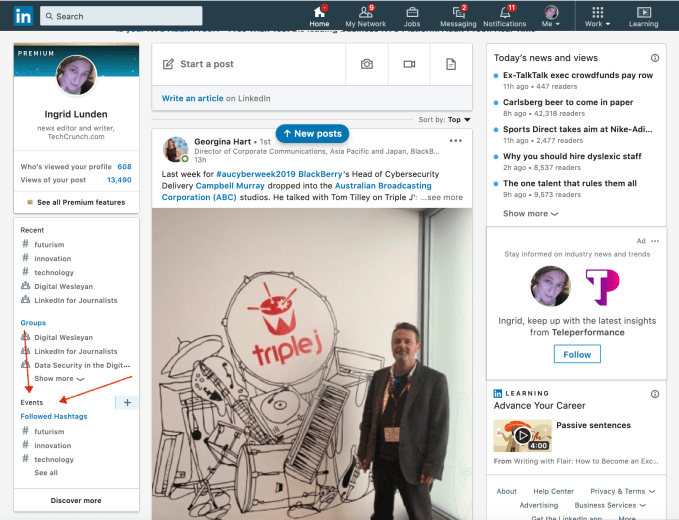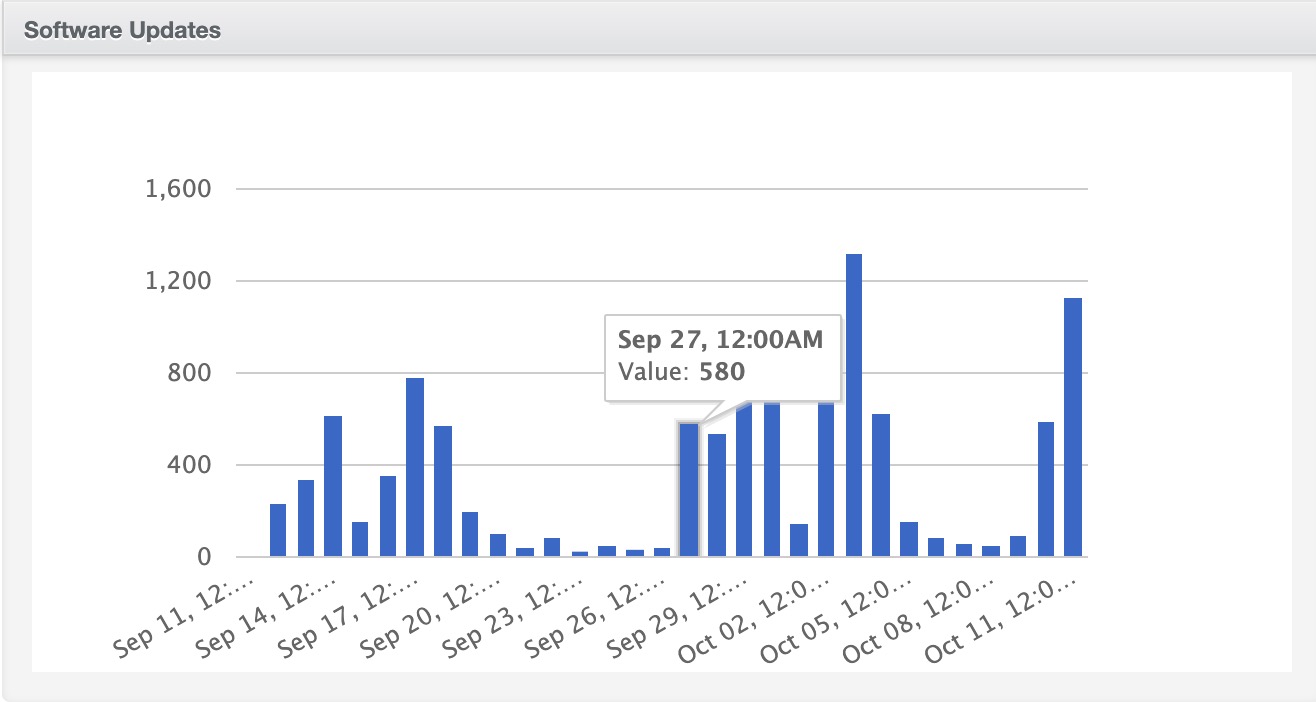Music
Trailers
DailyVideos
India
Pakistan
Afghanistan
Bangladesh
Srilanka
Nepal
Thailand
StockMarket
Business
Technology
Startup
Trending Videos
Coupons
Football
Search
Download App in Playstore
Download App
Best Collections
Technology
LinkedIn, the Microsoft-owned social network for the working world with around 650 million users, is known best as a place where people connect with each other online either to build work connections, for recruitment, or for professional development. Now, the company is taking a step to bring its networking features into the physical world: the company is launching a new feature called Events, a (currently free) tool for people to plan, announce and invite people to meetups and other get-togethers, in the physical world.
The feature — which will appear as a menu item in LinkedIn website and mobile app — is rolling out first in English-speaking countries starting October 17, with the aim to expand it to further non-English markets soon after that.
Ajay Datta, the head of product for LinkedIn India (where the app was developed; more on that below), believes that there is a clear gap in the market for a feature like this, much like you could argue Facebookevents feature has served a role in the out-of-work world to plan casual events.
&I think there is a massive whitespace for events today,& he said. &People don&t have a single place to organise [work-related] offline meetups specific to an industry or a neighborhood. People want to find other people.&
You may recall a limited trial of the Events feature about a year ago in New York and San Francisco: the kinds of events that LinkedIn said were created with the pilot included meetups, training sessions, offsites, sales events and happy hours, so expect to see these popping up in the live product, too.

Events is also important because it is the first major, global feature to be built out of the companyR-D office in Bangalore, India — a significant milestone for the team of engineers and others that are based there. Up to now, much of the work that they have done has been focused on regional tools or those specifically targeting emerging markets.
LinkedIn Lite, the companypared-down Android app for users in bandwidth-constrained markets, has probably been the Bangalore officebiggest win so far: it has now passed 10 million downloads in the 70+ countries where it is available.
To be clear, right now, Events is free to use and is fairly limited in its first iteration. You can create an announcement and invite first-person contacts, but you have no way to promote the event beyond your own organic reach on the platform (and wherever you might want to share the link outside it).
&Targeting is not the focus right now,& said Ajay Datta, the head of product at LinkedIn India. &Organic adoption is what we are looking for first before we look at anything else.&
You can lay out your plans, but there are no links to services to find and book out available spaces. You can&t create any ticketing or other limitations on attendance numbers, but you can include links to places where you might be able to manage such things, such as Eventbrite or any of its many competitors.
But if this starts to see traction — and I suspect that it will, because of its natural proximity to the social network to amplify an event, and the fact that most of the people who are hanging out on LinkedIn are likely to already be predisposed to engaging on it — you could imagine how LinkedIn might start to add on all of the above, and more. It says that other areas where itcontinuing to experiment to facilitate better in-person connections using includeQR codes, business cards, and proximity-based beacons.
This could help LinkedIn create another revenue stream in its business — or at least provide another way to boost existing revenue streams such as premium memberships (access to a wider circle of people to invite), advertising and recruitment solutions. Potentially, this could help pave the way to positioning LinkedIn (and by association, Microsoft) as an Eventbrite competitor.
From the Events menu bar, you will be able to create events yourself and also invite others. It looks like italready live on my own account, so here is how it looks from there:

And herehow the event-creation window looks. As you can see, you post links through to other sites for ticketing, and potentially further details about agendas and more. Each box has a limit on

LinkedIn is also being cognisant of its reputation for how the platform can be used for over-aggressive contacting, and so italso including security features for people to report and block suspicious events or conversations related to them. Italso applying AI algorithms to the events that do get listed to screen them for bad actors and bogus content, which then get assessed by human reviewers for further action.
The move into Events is one of the bigger moves that LinkedIn has made over the last several years — another big one has been its efforts in educational content — to open itself up to a new area of business by leveraging how it uses the professional graph that it has built up over time. It sometimes feels to me that under Microsoft (which bought the company for $26 billion in 2016) the company has been less productive in terms of launching new services and generally making noise, so this move is interesting in that sense too.
Still, the synergy between online networking and physical networking is so close that ita surprise that the company hadn&t launched an Events feature before now. All the more because Linked has dabbled in building tools to help people make better connections with each other when they are in the same physical space before.
Years ago it launched a Connected appto help people maximise the kinds of connections they make in the physical world. It has since been sunset and integrated into the main LinkedIn app, which has a &find nearby& feature that you can use to see if people who are your connections are, say, at the same conference as you are, or if you&re meeting a contact for coffee and don&t know what the person looks like.
Italso been over the last three months seeding the idea of associating actual events with LinkedIn the platform by encouraging the organising of &LinkedIn Local& events, which apparently have created more feedback from users to build an Events too, too.
Itnot clear why ittaken so long — LinkedIn sometimes does take its time, as it did with video — but in this period when some of us are beginning to pause and ponder what being online too much does for our ability to relate to each other, collaborate and progress not just in the working world, but in the wider world, itan interesting moment to choose to launch Events. We&ll see if LinkedInners agree.
- Details
- Category: Technology
Read more: LinkedIn gets physical, debuts Events hub for people to plan in-person networking events
Write comment (98 Comments)If you haven&t heard, TechCrunch has officially launched a weekly newsletter dedicated to all the ways people and goods move from Point A to Point B — today and in the future — whether itby bike, bus, scooter, car, train, truck, flying car, robotaxi or rocket. Heck, maybe even via hyperloop.
Earlier this year, we piloted a weekly transportation newsletter. Now, we&re back with a new name and a format that will be delivered into your inbox every Saturday morning. We&re calling it The Station, your hub of all things transportation. I&m your host, senior transportation reporter Kirsten Korosec.
Portions of the newsletter will be published as an article on the main site after it has been emailed to subscribers (thatwhat you&re reading now). To get everything, you have to sign up. And itfree. To subscribe, go to our newsletters page and click on The Station.
This isn&t a solo effort. Expect analysis and insight from senior reporter Megan Rose Dickey, who has been covering micromobility. TechCrunch reporter Jake Bright will occasionally provide insight into electric motorcycles, racing and the startup scene in Africa. And then of course, there are other TechCrunch staffers who will weigh in from their stations in the U.S., Europe and Asia.
We love the reader feedback. Keep it coming. Email me atThis email address is being protected from spambots. You need JavaScript enabled to view it. to share thoughts, opinions or tips or send a direct message to @kirstenkorosec.
A new autonomous vehicle company on the scene

Deeproute.ai is the newest company to receive a permit from the California Department of Motor Vehicles to test autonomous vehicles on public roads.
Here is what we know so far. The Chinese startup just raised$50 million in a pre-Series A funding round led by Fozun RZ Capital,theBeijing-based venture capital arm of Chinese conglomerate Fosun International. The company has research centers inShenzhen, Beijing and Silicon Valley and is aiming to build a full self-driving stack that can handle Level 4 automation, a designation by the SAE that means the vehicle can handle all aspects of driving in certain conditions without human intervention.
Deeproute.ai is also a supplier for Chinasecond-largest automaker Dongfeng Motor, according to TechNode. The startup plans to offer robotaxi services in partnership with Dongfeng Motor for the Military World Games in the city of Wuhan next month.
Snapshot: Tesla Smart Summon
 Remember way back in September when Tesla started rolling out its V10 software update? The software release was highly anticipated in large part because it included Smart Summon, an autonomous parking feature that allows owners to use their app to summon their vehicles from a parking space.
Remember way back in September when Tesla started rolling out its V10 software update? The software release was highly anticipated in large part because it included Smart Summon, an autonomous parking feature that allows owners to use their app to summon their vehicles from a parking space.
We have some insight into the rollout, courtesy of TezLab, a Brooklyn-based startup that developed a free app thatlike a Fitbit for a Tesla vehicle. Tesla owners who download the app can track their efficiency, total trip miles and use it to control certain functions of the vehicle, such as locking and unlocking the doors, and heating and air conditioning. TezLab, which has 20,000 active users and logs more than 1 million events a day, has become a massive repository of Tesla data.
TezLab shared the data set below that shows the ebb and flow of Teslasoftware updates. The X axis shows the date (of every other bar) and a timestamp of midnight. (Because this is a screenshot, you can&t toggle over it to see the time.)

This data shows when Tesla started pushing out the V10 software as well as when it held it back. The upshot? Notice the pop on September 27. Thatwhen the public rollout began in earnest, then dipped, then spiked again on October 3 and then dropped for almost a week. That lull followed a slew of social media postings demonstrating and complaining about the Smart Summon feature, suggesting that Tesla slowed the software release.
A geofencing bright spot
Speaking of Smart Summon, you might have seen the Consumer Reports review of the feature. In short, the consumer advocacy group called it &glitchy& and wondered if it offered any benefits to customers. I spoke to CR and learned a bit more. CR notes that Tesla is clear in its manual about the limitations of this beta product. The organizationcriticism is that people don&t have insight into these limitations when they buy the &Full Self-Driving& feature, which costs thousands of dollars. (CEO Elon Musk just announced the price will go up another $1,000 on November 1.)
One encouraging sign is that CR determined that the Smart Summon feature was able (most of the time) to recognize when it was on a public road. Smart Summon is only supposed to be used in private areas. &This is the first we&ve seen Tesla geofence this technology and that is a bright spot,& CR told me.
Deal of the week

There were plenty of deals in the past week, but the one that stood out — for a variety of reasons — involved German urban air mobility startup Lilium . Editor Ingrid Lunden had the scoop that Lilium has been talking to investors to raise between $400 million and $500 million. The size of this yet-to-be-closed round and who might be investing is what got our attention.
Lilium has already raised more than $100 million in financing from investors, includingWeChat owner and Chinese internet giantTencent, Atomico, which was founded by Skype co-founder Niklas Zennström, and Obvious Ventures, the early-stage VC fund co-founded by TwitterEv Williams. International private banking and asset management group LGT and Freigeist (formerly called e42) are also investors.
TechCrunch is still hunting down details about who might be investing, as well as Liliumvaluation. (You can always reach out with a tip.)
Lunden was able to ferret out a few important nuggets from sources, including that Tencent is apparently in this latest round and the startup has been pitching new investors since at least this spring. The round has yet to close. Lilium isn&t the only urban air mobility — aka flying cars — startup that been shaking the investor trees for money the past six months. Liliumchallenge is attempting to raise a bigger round than others in an unproven market.
A little bird

We hear a lot. But we&re not selfish. Letshare. For the unfamiliar, a little bird is where we pass along insider tips and what we&re hearing or finding from reliable, informed sources in the industry. This isn&t a place for unfounded gossip. Sometimes, like this week, we&re just helping to connect the dots to determine where a company is headed.
Aurora, an autonomous vehicle startup backed by Sequoia Capitaland Amazon, published a blog post that lay outs its plans to integrate its self-driving stack into multiple vehicle platforms. Those plans now include long-haul trucks.
Self-driving trucks are so very hot right now. Aurora is banking on its recent acquisition of lidar company Blackmore to give it an edge. Aurora has integrated into a Class 8 truck its self-driving stack known as &Aurora Driver.& We hear that Aurora isn&t announcing any partnerships — at least not now — but itsignaling a plan to push into this market.
Got a tip or overheard something in the world of transportation? Email me at This email address is being protected from spambots. You need JavaScript enabled to view it. to share thoughts, opinions or tips or send a direct message to @kirstenkorosec.
Keep (self) truckin&

Ike, the autonomous trucking startup founded by veterans of Apple, Google and Uber Advanced Technologies Groupself-driving truck program, has always cast itself as the cautious-we&ve-been-around-the-block-already company.
That hasn&t changed. Last week, Ike released a lengthy safety report and accompanying blog post. Itbeefy. But here are a few of the important takeaways. Ike is choosing not to test on public roads after a year of development, unlike most others in the space. Ike has a fleet of four Class 8 trucks outfitted with its self-driving stack as well as a Toyota Prius used for mapping and data collection. The trucks are driven manually, (a second engineer always in the passenger seat) on public roads. The automation system is then tested on a track.
There are strong incentives to demonstrate rapid progress with autonomous vehicle technology, and testing on public roads has been part of that playbook. And Ikefounders are taking a different path; and we hear that the approach was embraced, not rejected, by investors.

In the next issue of the newsletter, check out snippets from an interview with Randol Aikin, the head of systems engineering at Ike. We dig into the companyapproach, which is based on a methodology developed at MIT called Systems Theoretic Process Analysis (STPA) as the foundation for Ikeproduct development.
In other AV truck-related news, Kodiak Robotics just hired Jamie Hoffacker as its head of hardware. Hoffacker came from Lyft Level 5 self-driving vehicle initiative and also worked on GoogleStreet View vehicles. The company tells me that Hoffacker is key to its aim of building a product that can be manufactured, not just a prototype. Check out Hoffackerblog post to get his perspective.
Nos vemos la próxima vez.
- Details
- Category: Technology

As cannabis dispensaries flourish across the country alongside the push to legalize medicinal and recreational marijuana use, demand for tools to manage the specificities of the weed retail business continues to increase.
Looking to address that need, Flowhub, a cannabis retail management software vendor, has raised $23 million from a consortium of investors including e.ventures, Evolv Ventures (the Kraft Heinz-backed venture capital fund) and Poseidon.
The legal cannabis market is expected to top $66 billion over the next five years, according to estimates from Grand View Research, and entrepreneurs looking to get into the highly regulated industry are flocking to Flowhubsuite of dispensary management services.
Not only does the companysoftware address compliance concerns, according to chief executive officer Kyle Sherman, but it also integrates with companies like Dutchie for online ordering to facilitate in-store purchases and adds integrations with LeafBuyer and Leafly to provide more information to potential retailers.
The company also updated its software to include the &Stash& app, a mobile inventory management system, and a cashier app that integrates with iPads or other tablets to improve point-of-sale capabilities.
&What we are experiencing right now is an end to cannabis prohibition and Flowhub is on the front lines of this movement,& said Sherman, in a statement. &Every legal transaction completed with the Flowhub retail platform is a positive step forward, and we are committed to helping our customers build thriving cannabis businesses. With this investment, we will continue to automate the cannabis supply chain, retail and reporting processes and bring to market technology solutions that are not only shaping the cannabis retail business, but also driving forward the future of legalization and de-stigmatization.&
For investors like Emily Paxhia, a managing director at Poseidon, the opportunity to back a company helping to automate compliance in the regulated marijuana industry was too tempting to pass up.
&The compliance and regulation aspects make this a unique industry and Flowhub is one of the leading cannabis tech companies that is taking a meticulous and strategic approach,& Paxhia said in a statement. &We saw the potential for Flowhubtechnology and mission early on and we&re thrilled to continue to support them in delivering the cannabis retail experience of the future.&
- Details
- Category: Technology
Read more: Flowhub raises $23 million for its retail management software for cannabis dispensaries
Write comment (91 Comments)

It probably won't come as much of a surprise that the new Google Pixel 4 XL has an improved display over last year's model, but now DisplayMate, the world's leading authority on smartphone displays, has officially confirmed it, awarding the handset its highest possible score, as spotted by Ausdroid.
In its thorough tests, DisplayMate notes a number
- Details
- Category: Technology
Read more: Pixel 4 XL OLED screen nabs DisplayMate’s highest possible score
Write comment (100 Comments)

Google just got done away with a formal announcement about its next generation products including the much-awaited Pixel 4 series. And while the those who were following the developments got to know all about the phone before its launch, thanks to the numerous leaks, Google itself corroborated some of the speculations.
However, not until the last
- Details
- Category: Technology
Read more: Google won't sell Pixel 4 Pixel 4XL in India, here's why
Write comment (98 Comments)

Ratan Tata, the former chairman of Tata Sons is going to invest in Tork Motors, an electric two-wheeler startup based out of Pune.
Tork Motors is going to unveil its flagship electric bike, the Tork T6X in the coming months. It is an entirely indigenously developed electric vehicle, and will be one of the first ones available in India when it comes
- Details
- Category: Technology
Read more: Ratan Tata to invest in electric two-wheeler startup Tork Motors
Write comment (94 Comments)Page 620 of 5614

 11
11





